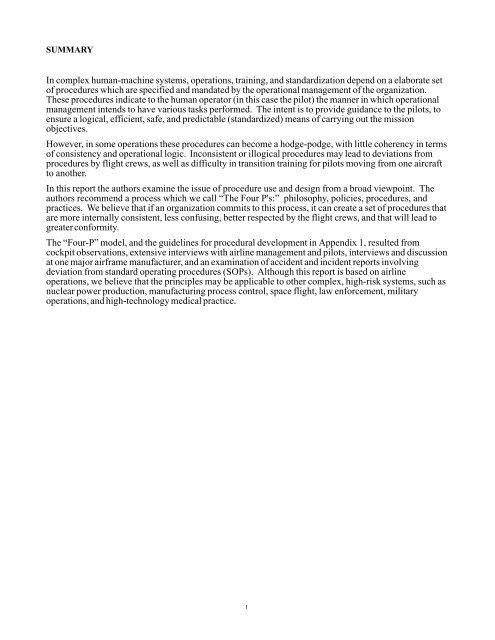On the Design of Flight-Deck Procedures - Intelligent Systems ...
On the Design of Flight-Deck Procedures - Intelligent Systems ...
On the Design of Flight-Deck Procedures - Intelligent Systems ...
You also want an ePaper? Increase the reach of your titles
YUMPU automatically turns print PDFs into web optimized ePapers that Google loves.
SUMMARYIn complex human-machine systems, operations, training, and standardization depend on a elaborate set<strong>of</strong> procedures which are specified and mandated by <strong>the</strong> operational management <strong>of</strong> <strong>the</strong> organization.These procedures indicate to <strong>the</strong> human operator (in this case <strong>the</strong> pilot) <strong>the</strong> manner in which operationalmanagement intends to have various tasks performed. The intent is to provide guidance to <strong>the</strong> pilots, toensure a logical, efficient, safe, and predictable (standardized) means <strong>of</strong> carrying out <strong>the</strong> missionobjectives.However, in some operations <strong>the</strong>se procedures can become a hodge-podge, with little coherency in terms<strong>of</strong> consistency and operational logic. Inconsistent or illogical procedures may lead to deviations fromprocedures by flight crews, as well as difficulty in transition training for pilots moving from one aircraftto ano<strong>the</strong>r.In this report <strong>the</strong> authors examine <strong>the</strong> issue <strong>of</strong> procedure use and design from a broad viewpoint. Theauthors recommend a process which we call “The Four P's:” philosophy, policies, procedures, andpractices. We believe that if an organization commits to this process, it can create a set <strong>of</strong> procedures thatare more internally consistent, less confusing, better respected by <strong>the</strong> flight crews, and that will lead togreater conformity.The “Four-P” model, and <strong>the</strong> guidelines for procedural development in Appendix 1, resulted fromcockpit observations, extensive interviews with airline management and pilots, interviews and discussionat one major airframe manufacturer, and an examination <strong>of</strong> accident and incident reports involvingdeviation from standard operating procedures (SOPs). Although this report is based on airlineoperations, we believe that <strong>the</strong> principles may be applicable to o<strong>the</strong>r complex, high-risk systems, such asnuclear power production, manufacturing process control, space flight, law enforcement, militaryoperations, and high-technology medical practice.1
















